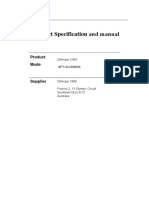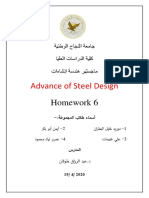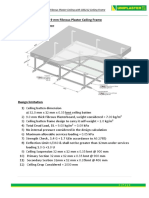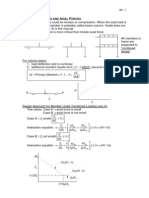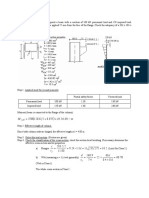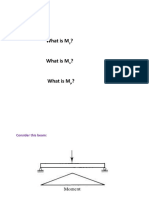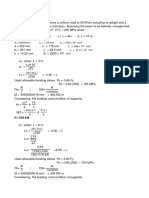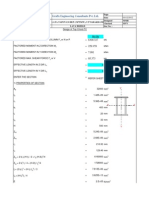Beam Column
Uploaded by
obsid.jeberth123Beam Column
Uploaded by
obsid.jeberth123BEAM – COLUMNS
Structural members subjected to combined axial compression and flexural loading are called Beam-
Column.
Interaction Equations
𝑃𝑟
For ≥ 0.2 Larger Axial Compression
𝑃𝑐
𝑃𝑟 8 𝑀𝑟𝑦
𝑃𝑐
+ 9
⟮ 𝑀𝑀𝑟𝑥 + 𝑀𝑐𝑦
⟯ ≤1.0
𝑐𝑥
𝑃𝑟
For < 0.2 Smaller Axial Compression
𝑃𝑐
𝑃𝑟 𝑀𝑟𝑦
2𝑃𝑐
+ ⟮𝑀
𝑀
𝑟𝑥
+ 𝑀𝑐𝑦
⟯ ≤1.0
𝑐𝑥
Pr = required axial compression strength
𝑃𝑛
Pc = allowable axial compression strength , Pc = ФcPn (LRFD) or ( ASD)
Ω𝑐
Mr = required flexural strength b
𝑀𝑛
Mc = allowable flexural strength Mc = ФbMn (LRFD) or ( ASD)
Ω𝑏
Where: Фc & Фb = 0.90 while Ω𝑐 & Ω𝑏 = 1.67
Problem 1:
The beam column shown is pinned at both ends and is subjected
to the load shown. Bending is about the strong axis. Determine
whether this member satisfies the appropriate AISC specification
interaction equation . A992 steel, Fy= 345 MPa and Fu=448.5 MPa .
Assumed compact section.(Do not consider moment amplification
due to the effect of secondary moment.
Properties of W10 x 49
Area Depth Web Flange width Flange thickness Distance Nominal weight
designation A d tw bf tf K per meter
(sq mm) (mm) (mm) (mm) (mm) (mm) (kg/m)
W 10 x 49 9290 253.49 8.64 254 14.22 30.16 73
ELASTIC PROPERTIES PLASTIC
Axis X-X Axis Y-Y MODULUS
Ix Sx r Iy Sy r Zx Zy
6 4 3 3 6 4 3 3 3 3
1x10 mm 1x10 mm mm 1x10 mm 1x10 mm mm 1x10 mm 1x103 mm3
11.3 895 110.49 39 305 64.52 990 454
Solution:
Check if
𝑃𝑢
≥ 0.2
Ф𝑃𝑛
Pu = 1.2 (155) + 1.6 (440) = 890 KN
Solving for Pn;
𝒌𝑳𝒚 (𝟏)(𝟓𝟐𝟎𝟎)
= = 80.595
𝒓𝒚 𝟔𝟒.𝟓𝟐
200000
cc =4.71√ = 113.403 > 80.595 Int. column
345
𝜋2 (200,000)
Fe = (80.595) 2
= 303.887 MPa
345
Then Fcr = [0.658303.997 ](345) =214.512 MPa >
Pn = 214.512 (9,290 ) = 1992.821 KN
𝑃𝑢 890,000
= = 0.496 ≥ 0.2 Larger Axial Compression
Ф𝑃𝑛 (0.90)(1992.821)
𝑃𝑢 8 𝑀𝑢𝑥 𝑀𝑢𝑦
Ф𝑃𝑛
+ ⟮
9 Фb𝑀
+
Фb𝑀𝑛𝑦
⟯ ≤1.0
𝑛𝑥
Solving for Mux:
Qu = 1.2(22) + 1.6(53) = 112 KN
𝑄𝑢 𝐿 (111.2(5.2)
Mux= = = 114.56
KN-m
4 4
Solving for ФMux: check first the lateral support.
Lb =5,200 mm
𝐸
Lp= 1.76𝑟𝑦√𝐹𝑦 = 1.76(64.52)√200,000
345
= 2,734.09 mm
2
2 √𝐼𝑦 𝐶𝑤
𝐸
Lr= 1.95𝑟𝑡𝑠 0.7𝐹 √𝑠
𝐽𝑐
√1 + √1 + 6.76 (0.7𝐹𝑦 𝑆𝑥 ℎ𝑜) , where; 𝑟𝑡𝑠 = , 𝑟𝑡𝑠 = 72.202
𝑦 𝑥 ℎ𝑜 𝐸𝐽𝑐 𝑆𝑥
From Manual J = 538342.5107 mm4 and Cw=555.87x109 mm6
Lr= 14,787 mm > Lb (partially supported)
𝑳𝒃 −𝑳𝒑
Mn =𝑪𝒃 [𝑴𝒑 − (𝑴𝒑 − 𝟎. 𝟕𝑭𝒚 𝑺𝒙 ) ( )] ≤ 𝑴𝒑
𝑳𝒓 −𝑳𝒑
𝑴𝒑 = FyZx = 341.55 KN-m
Cb = 1.32
5.2−2.73
Mn =1.32 [341.55𝑥106 − (341.55𝑥106 − 0.7(345)(895𝑥103 )) ( )] ≤ 𝑀𝑝
9.417−2.73
Mn = 389.7 Kn-m > Mp
Therefore us Mn = Mp = 341.55 Kn-m
8 114.56
0.496 + ⟮
9 0.90(341.55)
+ 0 ⟯ ≤1.0
0.914 < 1.0 therefore the structure is safe
MOMENT AMPLIFICATION METHOD
The moment amplification method entails computing the maximum bending moment resulting from flexural loading
(traverse loads or member end moments) by the first order analysis, then multiplying by a moment amplification factor to
account for the secondary moment. Amplification factor is a multiplier used to increase the computed moment in a
member to account for the eccentricity of the load and is given as:
𝐶𝑚
Mu = B1Mnt + B2Mlt B1 = 𝑃 𝑢|
≥ 1.0 Pu = is the factored axial load
1−| 𝑃ⅇ
Pu = Pnt + B2Plt 1
B2 = 𝛼∑𝑃 ≥ 1.0 Pe =Eulers load given as
1− ∑𝑃 𝑛𝑡
ⅇ2
𝜋2 𝐸𝐼
Pe =
(𝑘𝐿)2
𝑀1
Cm = 0.6-0.4( )
𝑀2
Mu = required moment strength
Plt = factored axial load corresponding to sidesway condition
Pnt = factored axial load corresponding to the braced condition
Mnt = factored load moment assuming that no sidesway occurs, whether the frame is actually braced or not
( the subscript nt is for no translation)
MIt = factored load moment caused by sidesway ( the subscript lt is for lateral translation). This moment can be caused
by lateral loads or unbalanced gravity loads.Gravity load can be produce sidesway if the frame is unsymmetrical or if the
gravity load are unsymmetrical placed. MIt = 0 if the frame is actually braced.
B1 = amplification factor for the moment occurring in the member when it is braced against sidesway
B2 = amplification factor for the moments resulting from sidesway.
Value of Cm ( Moment Correction factor / Reduction coefficient)
Problem 2: (Braced Frame using amplification )
The member shown in the figure is braced against sidesway.
Bending is about the major axis. Check the adequacy
of W14 x 90 A572 Grade 60 Based on given loads.
The loads are 40% service live load and 60 % service deadload.
Area Depth Web Flange width Flange thickness Distance Nominal weight
designation A d tw bf tf K per meter
(sq mm) (mm) (mm) (mm) (mm) (mm) (kg/m)
W 14 x 90 17,097 356.11 11.18 368.81 18.03 34.93 134
ELASTIC PROPERTIES PLASTIC
Axis X-X Axis Y-Y MODULUS
Ix Sx r Iy Sy r Zx Zy
6 4 3 3 6 4 3 3 3 3
1x10 mm 1x10 mm mm 1x10 mm 1x10 mm mm 1x10 mm 1x103 mm3
416 2343 155.96 151 818 93.98 2573 1239
Pu = 1.2 (60% x 1200) + 1.6 (40% x1200 ) = 1632 KN
Mu1 = 1.2 (60% x 150) + 1.6 (40% x150 ) = 204 KN
Mu2 = 1.2 (60% x 160) + 1.6 (40% x160 ) = 217.6 KN
Check if
𝑃𝑢
≥ 0.2
Ф𝑃𝑛
Solving for Pn;
𝒌𝑳𝒚 (𝟏)(𝟒𝟎𝟎𝟎)
𝒓𝒚
= 𝟗𝟑.𝟗𝟖
= 42.562
200000
cc =4.71√ 413.66 = 10365 > 42.562 Int. column
𝜋2 (200,000)
Fe = (42.562)2
= 1089.647 MPa
413.66
Then Fcr = [0.6581089.647 ](413.66) =352,89MPa
Pn = 352.89 (17,097 ) = 6,033.33 KN
𝑃𝑢 1632
= (0.90)(6033.33) = 0.3006 ≥ 0.2 Larger Axial Compression
Ф𝑃𝑛
𝑃𝑢 8 𝑀𝑢𝑥 𝑀𝑢𝑦
Ф𝑃𝑛
+ ⟮
9 Фb𝑀
+ Фb𝑀𝑛𝑦
⟯ ≤1.0
𝑛𝑥
Solving for Mux:
Mux = B1xMnt + B2Mit where ;Mnt =217.6 KN-m
𝐶𝑚
B1 = 𝑃
𝑢|
≥ 1.0
1−| 𝑃ⅇ
𝑀1
Cm = 0.6-0.4(
𝑀2
)
(204)
Cm = 0.6-0.4(−
(217.6)
) = 0.975
𝜋2 𝐸𝐼 𝜋2 (200,000)(416 𝑥 106 )
Pe =
(𝑘𝐿)2
; Pe =
(1𝑥4000)2
= 5132194289 N
𝐶𝑚 (0.975)
B1 = 𝑃 = B1 = (1632𝑥103
= 1.007 > 1 ok
1−| 𝑢 | 1−| |
𝑃ⅇ 5132194289
Mux = (1.007) (217.6) = 219.12 KN-m
Solving for ФMux: check first the lateral support.
Lb =4,000 mm
𝐸
Lp= 1.76𝑟𝑦√𝐹𝑦 = 1.76(93.98)√200,000
413.66
= 3,636.98 mm
2
𝐸
Lr= 1.95𝑟𝑡𝑠 0.7𝐹 √𝑠
𝐽𝑐
√1 + √1 + 6.76 (0.7𝐹𝑦 𝑆𝑥 ℎ𝑜) ,
𝑦 𝑥 ℎ𝑜 𝐸𝐽𝑐
2 √(151x106 )(4296.57𝑥109 )
where; 𝑟𝑡𝑠 = , 𝑟𝑡𝑠 = 104.27
2343x103
From Manual J = 1.69 x106 mm4 and Cw=4296.57x109 mm6 ho= 337.82
200,000 (1.69x10 )(1) 6
0.7(413.33)((2343x10 )(337.82) 3 2
Lr= 1.95(104.7) 0.7(413.33) √(2343x103 )(337.82) √1 + √1 + 6.76 ( )
(200,000)(1.69x106 )(1)
Lr= 11,343 mm > Lb (partially supported)
𝑳𝒃 −𝑳𝒑
Mn =𝑪𝒃 [𝑴𝒑 − (𝑴𝒑 − 𝟎. 𝟕𝑭𝒚 𝑺𝒙 ) ( )] ≤ 𝑴𝒑
𝑳𝒓 −𝑳𝒑
MA = 204 + 3.4 (1) = 207.4
MB = 204 + 3.4 (2) = 210.8
MA = 204 + 3.4 (3) = 214.6
Mmax = 204 + 3.4 (4) = 217.6
𝟏𝟐.𝟓𝑴𝒎𝒂𝒙
Cb 𝑹𝒎 ≤ 3
𝟐.𝟓𝑴𝒎𝒂𝒙 +𝟑𝑴𝑨 +𝟒𝑴𝑩 +𝟑𝑴𝒄
𝟏𝟐.𝟓(𝟐𝟏𝟕.𝟔)
Cb (𝟏) = 1.026
𝟐.𝟓(𝟐𝟏𝟕.𝟔) +𝟑(𝟐𝟎𝟕.𝟒)+𝟒(𝟐𝟏𝟎.𝟖)+𝟑(𝟐𝟏𝟒.𝟔)
𝑳𝒃 −𝑳𝒑
Mn =𝑪𝒃 [𝑴𝒑 − (𝑴𝒑 − 𝟎. 𝟕𝑭𝒚 𝑺𝒙 ) ( )] ≤ 𝑴𝒑
𝑳𝒓 −𝑳𝒑
𝑴𝒑 = FyZx = (413.33)(2573x103) = 1,063.50 KN-m
6 6 3 𝟒−𝟑.𝟔
Mn =(𝟏. 𝟎𝟐𝟔) [𝟏, 𝟎𝟔𝟑. 𝟓 𝒙10 − (𝟏, 𝟎𝟔𝟑. 𝟓 𝒙10 − 𝟎. 𝟕(𝟒𝟏𝟑. 𝟑𝟑)(2343x10 )) (𝟏𝟏.𝟑𝟒−𝟑.𝟔 )] ≤ 𝑴𝒑
Mn = 1,070.70 KN-m > Mp therefore use Mn=1,063.50 KN-m
8
0.3006+ 9
⟯= 0.5027 < 1.0 safe
Problem 3) A 7 m grade 60 W10x60 eccentrically loaded column as shown carries an eccentric service load of 190 KN
placed at a certain distance of 180 mm from the x-axis and a distance “e” from the y-axis. Determine the the maximum
distance “e” if the ends of the column are translation fixed and rotation free. The given load is 40% deadload and 60%
liveload. Assumed compact section and laterally supported all throughout the length. Use Cm= 1.0
W 10 x 60 Properties:
d= 260 mm
A= 11,400 mm2
Ix = 142 x 106 mm4
Iy= 48 x 106 mm4
rx = 111.8 mm
ry= 65.1 mm
Zx = 1222 x 103 mm3
Zy = 574 x 103 mm3
Solution:
Pu =1.2(40% x 190) + 1.6 (60% x 190) = 273.6 KN
Since compact section and laterally supported
Mnx = Fy Zx
Mny = Fy Zy
Mux = Pu(0.18 m) = 49.248 KN-m and Muy = Pu( e ) = 273.6 e
𝑃𝑢
Solving for =
Ф𝑃𝑛
Solving for Pn;
𝒌𝑳𝒚 (𝟏)(𝟕𝟎𝟎𝟎)
= = 107.527 for grade 60 steel , Fy = 60 Ksi = 413,66 MPa
𝒓𝒚 𝟔𝟓.𝟏
29,000
cc =4.71√ 60
= 103.55 < 107.527 m (long column)
𝜋2 (200,000)
Fe = (107.527)2
= 170.724 MPa
Then Fcr =0.877 Fe = 0.877 (170.724) =149.725 MPa
Pn = 149.725 (11,400 ) = 1,706.865 KN
𝑃𝑢 273.6
Therefore = = 0.1781 < .02 (smaller axial compression)
Ф𝑃𝑛 𝟎.𝟗𝟎( 𝟏,𝟕𝟎𝟔.𝟖𝟔𝟓)
𝑃𝑢 𝑀𝑢𝑥 𝑀𝑢𝑦
Use :
2Ф𝑃𝑛
+ ⟮ Фb𝑀 + Фb𝑀𝑛𝑦
⟯ ≤1.0
𝑛𝑥
Mux = B1xMntx Muy = B1yMnty
𝐶𝑚𝑥 𝜋2 𝐸𝐼
B1x = 𝑢| 𝑃 ≥ 1.0 Pu = is the factored axial load and Pe =
(𝑘𝐿)2
1−|𝑃ⅇ𝑥
𝜋2 (200,000)(142 𝑥106
Pex =
(1 𝑥 7000)2
= 5,720.342 KN
1.0
B1x = 273.6 = 1.055
1−|5720.342|
𝜋2 (200,000)(48 𝑥106 )
Pey =
(1 𝑥 7000)2
= 1,933.636KN
1.0
B1y = 273.6 = 1.165
1−|1933.636|
Mnx = Mpx = FyZx = (60 x 6.9) (1222 x 103) = 505.908 KN-m
Mny = Mpy = FyZy = (60 x 6.9) (574 x 103) = 237.636 KN-m
Applying moment amplification factor, B1x and B1y
𝑃𝑢 𝑀𝑢𝑥 𝑀𝑢𝑦
2Ф𝑃𝑛
+ ⟮ Фb𝑀 + Фb𝑀𝑛𝑦
⟯ ≤1.0
𝑛𝑥
0.1781
2
+ ⟮ ((1.055)(49.248)
0.90)(505.908)
+
(1.165)(273.6𝑒)
(0.90)(237.636)
⟯ ≤1.0
e ≤ 0.535 m.
You might also like
- AGMA 6022-C93 Design Manual For Cylindrical Wormgearing100% (1)AGMA 6022-C93 Design Manual For Cylindrical Wormgearing44 pages
- Examples On Design of Flexural Members: M KN X X MNo ratings yetExamples On Design of Flexural Members: M KN X X M9 pages
- International Journal of Fatigue: Urbi Pal, Goutam Mukhopadhyay, Ankush Sharma, Sandip BhattacharyaNo ratings yetInternational Journal of Fatigue: Urbi Pal, Goutam Mukhopadhyay, Ankush Sharma, Sandip Bhattacharya7 pages
- Tuning, Calibration, and Optimization Guide: Part Number: 1018437 A May 2005100% (1)Tuning, Calibration, and Optimization Guide: Part Number: 1018437 A May 200588 pages
- Jurusan Teknik Sipil Sekolah Tinggi Teknologi YPKP: Ir. Muhamad Ryanto, MTNo ratings yetJurusan Teknik Sipil Sekolah Tinggi Teknologi YPKP: Ir. Muhamad Ryanto, MT9 pages
- Design Input:: Design Sheet Title: Design of Anchor Bolts & Base Plate For A Fixed Base Column Ameya STDNo ratings yetDesign Input:: Design Sheet Title: Design of Anchor Bolts & Base Plate For A Fixed Base Column Ameya STD4 pages
- Design Calculation For 9 MM Fibrous Plaster CeilingNo ratings yetDesign Calculation For 9 MM Fibrous Plaster Ceiling13 pages
- Review:: What Is M ? What Is M ? What Is M ?No ratings yetReview:: What Is M ? What Is M ? What Is M ?50 pages
- RCD - Interaction Diagram & Long Column: ExampleNo ratings yetRCD - Interaction Diagram & Long Column: Example8 pages
- 3 Flanged Beams Practice Problems SolutionsNo ratings yet3 Flanged Beams Practice Problems Solutions17 pages
- Beam Column:: Required Strength Available Strength 1.0 Eq. 1No ratings yetBeam Column:: Required Strength Available Strength 1.0 Eq. 117 pages
- Unit 2: Biochemistry Guided Notes Student VersionNo ratings yetUnit 2: Biochemistry Guided Notes Student Version12 pages
- 1st Summative Test (4th Quarter) ReviewerNo ratings yet1st Summative Test (4th Quarter) Reviewer1 page
- Stars Academy Lahore: Stars Entry Test System - 2019No ratings yetStars Academy Lahore: Stars Entry Test System - 20192 pages
- Product Specification: Shenzhen Angell Technology Co., LTD100% (1)Product Specification: Shenzhen Angell Technology Co., LTD4 pages
- Serial-10 CHAPTER VIII-Design of Water TankNo ratings yetSerial-10 CHAPTER VIII-Design of Water Tank21 pages
- Vertex Form of Parabolas: y X X + 71 y X X 5No ratings yetVertex Form of Parabolas: y X X + 71 y X X 52 pages
- Techno-Economic Comparison of The ORC and The PEORC For Low-Temperature Industrial Waste Heat RecoveryNo ratings yetTechno-Economic Comparison of The ORC and The PEORC For Low-Temperature Industrial Waste Heat Recovery9 pages
- (Ebook) Stochastic Equations in Infinite Dimensions by Prato G.D., Zabczyk J. ISBN 9781107055841, 1107055849 - Own the ebook now and start reading instantly100% (1)(Ebook) Stochastic Equations in Infinite Dimensions by Prato G.D., Zabczyk J. ISBN 9781107055841, 1107055849 - Own the ebook now and start reading instantly52 pages







